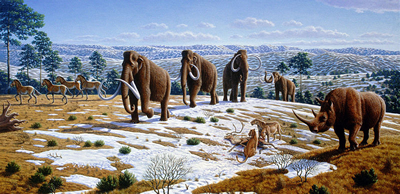The Earth has experienced five glaciations, periods when the temperature was cold enough for ice to form at the poles, in its 4 billion years ago history. The first, the Huronian Glaciation, took place slightly over two billion years ago. We are currently living during a period of glaciation know as the Quaternary.
Within each glaciation, there are warm, or interglacial periods when ice recedes, and cool periods when ice sheets spread further over the Earth’s surface. However, during both warm and cool periods of a glaciation, there is always some ice at the poles. Currently, we are living in a warm period. The Earth is not covered in ice, but there is ice at the North and South Pole.
Some people use the term “ice age” to mean a glaciation; others use it to mean a cool period within a glaciation. As we are living within an interglacial period during the Quaternary Glaciation, we may or may not be living in an ice age, depending on your definition of the term.
 Scientists know that glaciations occur when the Earth’s average temperature drops below a particular threshold, but they aren’t entirely sure what makes the temperature drop so low. They have developed some hypotheses:
Scientists know that glaciations occur when the Earth’s average temperature drops below a particular threshold, but they aren’t entirely sure what makes the temperature drop so low. They have developed some hypotheses:
Plate Tectonics
Plate Tectonics is a theory describing the movement of the Earth’s tectonic plates around the surface of the Earth. Because of plate tectonics, the shapes and positions of the continents have changed many times throughout our planet’s history. For example, all the continents we know today were once joined together in a supercontinent named Pangaea. Scientists think glaciations may have occurred when continents moved away from the equator and toward the poles.
The movement of tectonic plates explains why geological evidence shows that about 250 million years ago, Africa, Australia, India and South America were covered in ice sheets, but North America and Eurasia were not. During that time, all of those landmasses were part of Pangaea. The southern part of Pangaea, which contained Africa, Australia, India and South America, was at the South Pole. Therefore, these land areas were much colder than they are today.
When tectonic plates move, they can collide. Sometimes when this happens, a large section of a continent is lifted up. This can change the circulation patterns in the atmosphere and the ocean.
About 60 million years ago, the Indian subcontinent crashed into southern Asia. This caused land at the boundary to become uplifted. This land eventually became the Himalayas and the Tibetan plateau. Scientists think the uplifting of these regions contributed to the cooling that resulted in the current glaciation, which began a little over 2.5 million years ago.
Changes in Carbon Dioxide Levels
Just as increases in carbon dioxide levels can cause global warming, decreases in carbon dioxide levels, which could be caused by changes in ocean currents, interactions between living things and other factors, can cause global cooling.
Changes in the Earth’s Orbit
Scientists think variations in the Earth’s orbit can cause global cooling and global warming on a smaller timescale; they cause transitions between cool and warm periods within glaciations.
Scientists think the transitions between warm and cool periods during the current Quaternary Glaciations could have been caused by changes in the Earth’s orbit.
In the 1920s, Milutin Milankovitch, a Serbian scientist, hypothesized that by affecting the amount of solar radiation the Earth receives, changes in the Earth’s orbit play an important role in determining the Earth’s climate.
Milankovitch said three factors determine how much solar radiation reaches the Earth: the eccentricity of the Earth’s orbit, the angle of the Earth’s axis and the wobbling of the Earth’s axis.
These three factors undergo periodic changes in what are known as Milankovitch Cycles.
Milankovitch calculated how warm the Earth’s surface must have been in the past, based on changes in the Earth’s orbit, and tried to find a correlation between these changes and changes in climate during the current glaciation.
His work was largely ignored until the 1970s. Then, researchers determined how climate had changed over almost 500,000 years by studying climate sensitive organisms in deep sea sediments. They found a correlation between changes in the Earth’s orbit and changes in climate over the past several hundred thousand years and concluded that such changes were the fundamental causes of the cool periods of the Quaternary Glaciation.
Learn more about Climate Change History